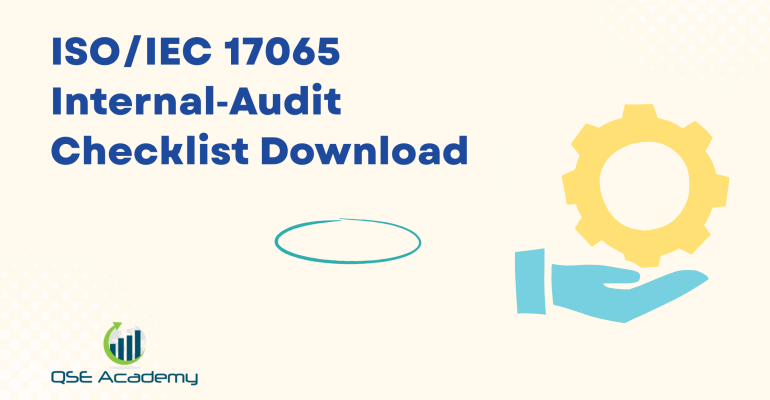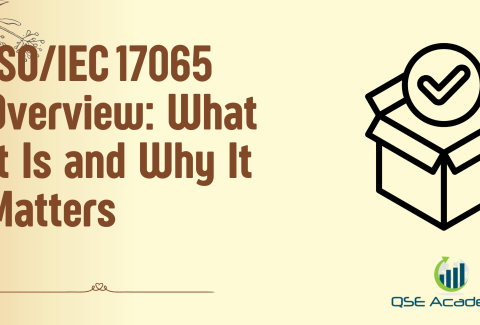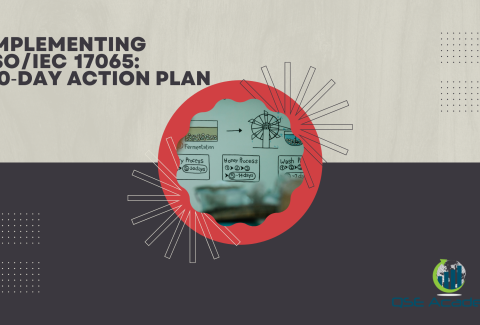ISO/IEC 17065 Internal‑Audit Checklist Download
Why an ISO/IEC 17065 Internal-Audit Checklist Matters for Accreditation Success
When I sit down with certification bodies preparing for ISO/IEC 17065 accreditation, the first thing I ask them is simple: “Show me your internal audit checklist.” You’d be surprised how often I’m handed a document that looks more like a formality than a tool for real evaluation.
Here’s what I’ve noticed over the years: internal audits become powerful only when they’re structured, clause-aligned, and detailed enough to uncover weaknesses before an accreditation body does. And that’s exactly why you’re here — you need a practical, ready-to-use checklist that guides your team through every requirement and helps you audit with confidence.
This article gives you clarity, direction, and a downloadable ISO/IEC 17065 internal-audit checklist designed for real operations — not theoretical compliance. You’ll understand how to use it, how to adapt it to your certification schemes, and how to avoid the mistakes that cost organizations their accreditation.
Understanding the Purpose of an ISO/IEC 17065 Internal-Audit Checklist
Here’s something I’ve seen repeatedly: teams rush through internal audits because they’re overwhelmed by the structure of ISO/IEC 17065. The wording can feel heavy, and it’s easy to miss small gaps that become big findings later.
A clause-aligned checklist gives you something solid to work with. It turns a complex standard into a structured pathway:
- What to check
- Where to look
- What evidence proves conformity
- What gaps indicate risk
This is important because an internal audit isn’t just a compliance activity — it’s your early-warning system.
Pro Tip: Link every audit question to objective evidence. If the question says “Evaluate impartiality mechanism,” the evidence column should show the risk assessment, committee decisions, and supporting records.
Common mistake: Asking generic questions like “Is impartiality ensured?” That’s too shallow. Break it down into sub-questions probing the real controls.
A few years ago, I worked with a product-certification body that failed its accreditation assessment simply because their internal-audit checklist didn’t include evidence verification. Their audit was “high-level,” and the assessor flagged it as ineffective. The fix took months. You don’t want that.
 How to Use the ISO/IEC 17065 Internal-Audit Checklist Effectively
How to Use the ISO/IEC 17065 Internal-Audit Checklist Effectively
I’ve walked entire audit teams through this process more times than I can count. The checklist works — but only when used correctly. Here’s the sequence I recommend:
- Plan the audit. Define scope, clauses, and personnel.
- Sample records. Don’t audit based on theory alone.
- Conduct interviews. Ask the people doing the work.
- Review documents and records. Cross-check facts.
- Capture non-conformities clearly. Use simple language.
- Rate compliance. Fully compliant, partial, or non-compliant.
Using a rating scale is one of the most efficient strategies I’ve introduced to teams. It reduces subjectivity and speeds up reporting.
Pro Tip: Write evidence in full sentences. “Reviewed training file of inspector X — competency reviewed annually” is much clearer than “OK.”
Common mistake: Not recording evidence because “it’s obvious.” If an assessor can’t see it, it doesn’t exist.
Here’s an example of a strong audit question structure:
- Clause: 7.5
- Question: Are evaluation activities performed according to scheme rules?
- Evidence: Testing records, evaluation reports, subcontractor results, traceability links
- Finding: Strengths, gaps, risks
That’s what real conformity looks like on paper.
ISO/IEC 17065 Clause-by-Clause Internal-Audit Questions
Now that we covered how to use the checklist, let’s go deeper into the clause flow. These sample questions will help you assess real compliance, not just documentation readiness.
Clause 4 – General Requirements
- How is impartiality managed and reviewed?
- Are confidentiality agreements updated and signed?
- Is legal compliance monitored and documented?
Clause 5 – Structural Requirements
- Do roles and responsibilities clearly distinguish evaluation and decision-making?
- Is the organizational structure documented and accessible?
- Are committees functioning according to defined rules?
Clause 6 – Resource Requirements
- Are personnel competency criteria defined and applied?
- Are training records up-to-date for evaluators and decision-makers?
- Are outsourced resources evaluated and approved?
Clause 7 – Process Requirements
- Are certification schemes documented and aligned with product categories?
- Are evaluation and testing activities transparent and traceable?
- Is the certification decision independent of evaluation results?
- Are surveillance and recertification activities controlled?
Clause 8 – Management System Requirements
- Are procedures for document control followed consistently?
- Are internal audits performed effectively and on schedule?
- Are corrective actions documented, implemented, and verified?
- Has management review addressed performance, complaints, risks?
Pro Tip: Tailor these questions based on your own product schemes. ISO/IEC 17065 is versatile — but your audit checklist needs specificity.
Pitfall to avoid: Copying audit questions from ISO/IEC 17021 or ISO/IEC 17025. The structure is similar, but the intent is different.
What’s Inside the Downloadable ISO/IEC 17065 Internal-Audit Checklist
The downloadable checklist isn’t just a list of questions. It’s built to guide you through a real audit. Here’s what’s inside:
- Clause-by-clause breakdown
- Evidence column
- Conformity rating scale
- Root-cause section
- Findings log
- Scheme-specific customization fields
- Risk observations
- Follow-up actions
You can modify it for your scheme types (electrical products, cosmetics, food packaging, PPE, etc.), your decision-making structure, and your record-keeping flow.
Pro Tip: Make a separate tab for scheme-specific questions. Accreditation bodies love seeing this level of tailoring.
Common mistake: Using a generic checklist and assuming it covers scheme rules. Scheme requirements vary widely — don’t take shortcuts.
Common ISO/IEC 17065 Internal-Audit Non-Conformities (And How to Avoid Them)
I wish I could say most findings are unique — but they’re not. The same gaps appear over and over:
- Impartiality risks not assessed annually
- Committee meeting minutes missing key decisions
- Testing/evaluation records missing traceability
- Competency matrix outdated
- Internal-audit report too superficial
- Corrective actions closed without evidence of effectiveness
The easiest way to avoid these issues is to build them into your internal-audit questions.
A certification body I worked with recently passed their reassessment because they spent extra time strengthening impartiality documentation. Previously, it had been flagged as a “major risk.” One focused effort made the difference.
Preparing Findings & Corrective Actions the Right Way
This is where the real improvement happens. A well-documented finding can become the foundation of better processes — if you treat it properly.
Here’s the method I recommend:
- State the issue clearly — no vague wording.
- Identify the root cause — not just the symptom.
- Define corrective actions — specific, measurable, traceable.
- Assign responsibility and deadlines.
- Verify effectiveness — re-audit if needed.
Pro Tip: Use the 5-Why technique. It’s simple but powerful when done honestly.
Common mistake: Closing findings too quickly. Take the time to verify the impact; otherwise, you’ll see the same issue again in six months.
FAQs – ISO/IEC 17065 Internal-Audit Checklist
Do I need a separate checklist for each certification scheme?
In my experience, yes. ISO/IEC 17065 requires scheme-specific controls, and one generic checklist won’t cover technical requirements. Add scheme-specific questions to keep it robust.
Can I reuse a checklist from ISO/IEC 17021 or ISO/IEC 17067?
You can use it as a structural reference, but don’t copy it blindly. The intent differs, and you’ll miss critical ISO/IEC 17065-specific controls.
How often should internal audits be conducted?
At least once a year. But when you’re implementing the system for the first time or facing scheme changes, twice a year is smarter.
Conclusion: Strengthen Your Internal-Audit System with the Right Tools
After working with so many certification bodies, I can tell you this with confidence: a strong internal-audit checklist is one of the best investments you can make for ISO/IEC 17065 readiness. It saves time, prevents non-conformities, and puts you in control of your system.
Melissa Lavaro is a seasoned ISO consultant and an enthusiastic advocate for quality management standards. With a rich experience in conducting audits and providing consultancy services, Melissa specializes in helping organizations implement and adapt to ISO standards. Her passion for quality management is evident in her hands-on approach and deep understanding of the regulatory frameworks. Melissa’s expertise and energetic commitment make her a sought-after consultant, dedicated to elevating organizational compliance and performance through practical, insightful guidance.









